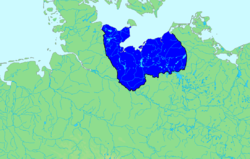You can help expand this article with text translated from the corresponding article in German. (March 2014)Click [show] for important translation instructions.
|
Obotritic confederation | |||||||||||||||||||
|---|---|---|---|---|---|---|---|---|---|---|---|---|---|---|---|---|---|---|---|
| 8th century–1167 | |||||||||||||||||||
Arms of the House of Nikloting, princes of the Obotritic confederation | |||||||||||||||||||
 Main territory of the Obotritic confederation | |||||||||||||||||||
 Expansion of the Obotritic confederation under Prince Thrasco († 809) after victory over the Nordalbingian Saxons | |||||||||||||||||||
| Status | Independent confederation of Polabian Slavic tribes | ||||||||||||||||||
| Capital | Veligard or Veligrad (German: Michelenburg) | ||||||||||||||||||
| Common languages | Polabian, Old Saxon | ||||||||||||||||||
| Religion | Polabian [a] Slavic paganism , the known major cults:
Chalcedonian Christianity (missionaries, some nobles) | ||||||||||||||||||
| Government | Hereditary monarchy (Principality) | ||||||||||||||||||
| Prince | |||||||||||||||||||
• ?–ca. 795 (first) | Witzlaus | ||||||||||||||||||
• 1160–1167 (last) | Pribislav | ||||||||||||||||||
| History | |||||||||||||||||||
• Formed | 8th century | ||||||||||||||||||
• Accepted Saxon suzerainty | 1167 | ||||||||||||||||||
| |||||||||||||||||||
| Today part of | Germany | ||||||||||||||||||
The Obotrites (Latin : Obotriti, Abodritorum, Abodritos) or Obodrites, also spelled Abodrites (German : Abodriten), were a confederation of medieval West Slavic tribes within the territory of modern Mecklenburg and Holstein in northern Germany (see Polabian Slavs). [1] For decades, they were allies of Charlemagne in his wars against the Germanic Saxons and the Slavic Veleti. The Obotrites under Prince Thrasco defeated the Saxons in the Battle of Bornhöved (798). The still-Pagan Saxons were dispersed by the emperor, and the part of their former land in Holstein north of Elbe was awarded to the Obotrites in 804, as a reward for their victory. This however was soon reverted through an invasion of the Danes. The Obotrite regnal style was abolished in 1167, when Pribislav was restored to power by Duke Henry the Lion, as Prince of Mecklenburg, thereby founding the Germanized House of Mecklenburg.





